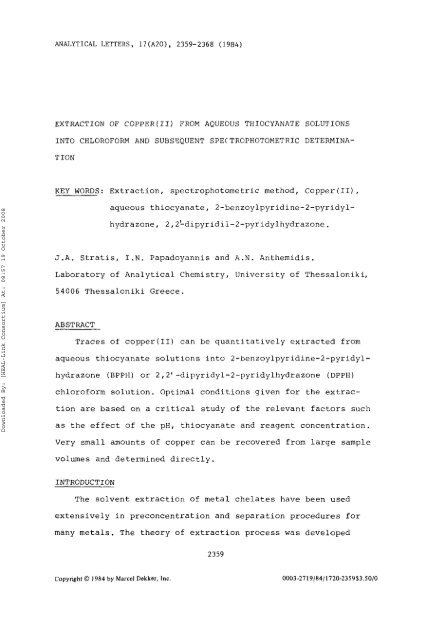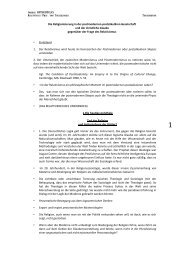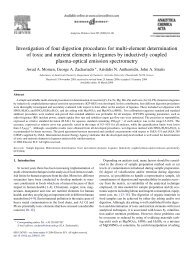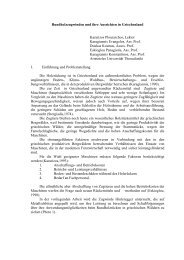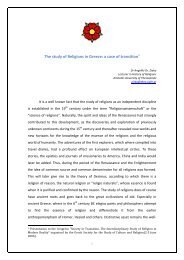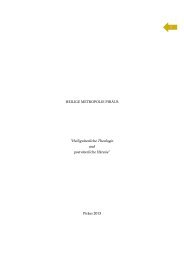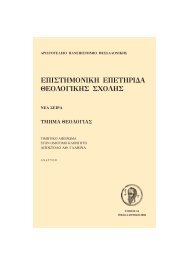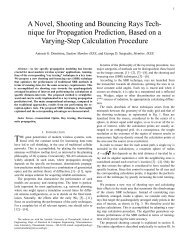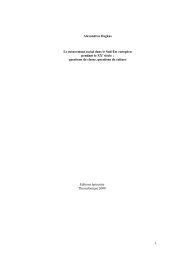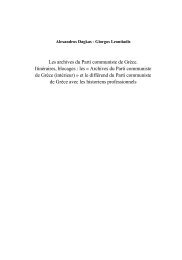Magazine: 3.pdf
Magazine: 3.pdf
Magazine: 3.pdf
Create successful ePaper yourself
Turn your PDF publications into a flip-book with our unique Google optimized e-Paper software.
Downloaded By: [HEAL-Link Consortium] At: 08:57 19 October 2008<br />
ANALYTICAL LETTERS, 17(A20), 2359-2368 (1984)<br />
EXTRACTION OF COPPER(I1) FROM AQUEOUS THIOCYANATE SOLUTIONS<br />
INTO CHLOROFORM AND SUBSSQUENT SPECTROPHOTOMETRIC DETERMINA-<br />
TION<br />
KEY WORDS: Extraction, spectrophotometric method, Copper(II),<br />
aqueous thiocyanate, 2-benzoylpyridine-2-pyridyl-<br />
hydrazone, 2,2Ldipyridil-Z-pyridylhydrazone.<br />
J.A. Stratis, I.N. Papadoyannis and A.N. Anthemidis.<br />
Laboratory of Analytical Chemistry, University of Thessaloniki,<br />
54006 Thessaloniki Greece.<br />
ABSTRACT<br />
Traces of copper(I1) can be quantitatively extracted from<br />
aqueous thiocyanate solutions into 2-benzoylpyridine-2-pyridyl-<br />
hydrazone (BPPH) or 2,2'-dipyridyl-2-pyridylhydrazone (DPPH)<br />
chloroform solution. Optimal conditions given for the extrac-<br />
tion are based on a critical study of the relevant factors such<br />
as the effect of the pH, thiocyanate and reagent concentration.<br />
Very small amounts of copper can be recovered from large sample<br />
volumes and determined directly.<br />
INTRODUCTION<br />
The solvent extraction of metal chelates have been used<br />
extensively in preconcentration and separation procedures for<br />
many metals. The theory of extraction process was developed<br />
Copyright 0 1984 by Marcel Dekker, Inc<br />
2359<br />
0003-27 19/84/ 1720-2359$3 .SO/O
Downloaded By: [HEAL-Link Consortium] At: 08:57 19 October 2008<br />
2360 STRATIS, PAPADOYANNIS, AND ANTHEMIDIS<br />
by Kolthoff and Sandel '<br />
by Oosting<br />
3,4,5<br />
, Irving and Williams and then<br />
The majority of chelating ligands used in extraction are<br />
weak acids, HL, which react in the form of their conjugate<br />
bases, L-, with metal ions, Mn+, to give uncharged extract-<br />
able chelates, ML,. In the last two decades some new orga-<br />
nic reagents have become available which can be considered as<br />
slightly modified ferroin chromagens. These include certain<br />
substituted hydrazones (-N=C-NH-N=C-c=N-) that were intro-<br />
duced by Lions et a1 6'7 Many of these reagents are very<br />
sensitive for spectrophotometric determination of metals and<br />
some of them have been examined for extraction of cations and<br />
their subsequent spectrophotometric rnicr~determination~'~<br />
It was observed, that some ions such as cyanide, cyanate, tllio-<br />
cyanate etc., increase the extraction of copper(I1) complex with<br />
pyridine-aldehyde-2-pyridylhydrazone (PAPHY), 2-benzoylpyridine-<br />
2-pyridylhydrazone (BPPH) and 2,2'-dipyridyl-2-pyridylhydrazone<br />
(DPPH) into organic solvents. An indirect determination of cya-<br />
nide, cyanate, thiocyanate and selenocyanate by atomic absorption<br />
spectroscopy and spectrophotometry was developed<br />
10,ll . These<br />
considerations prompted a study for possible copper preconcen-<br />
tration from aqueous solutions and spectrophotometric micro-<br />
determination of copper. A comparison between BPPH and DPPH<br />
for extraction of copper(I1) and subsequent spectrophotome-<br />
tric microdetermination of copper is reported.<br />
EXPERIMENTAL<br />
Reagents<br />
The synthesis of 2-benzoylpy+idine-2-pyridylhydrazone<br />
(BPPH) and 2,2'-dipyridyl-2-pyridylhydrazone (DPPH) has been<br />
I 1
Downloaded By: [HEAL-Link Consortium] At: 08:57 19 October 2008<br />
EXTRACTION OF COPPER(I1) 2361<br />
previously reported (1 2,13). Solutions of BPPH and DPPH were<br />
prepared by dissolving the required weight in chloroform<br />
and ethanol. These solutions are stable and can be kept<br />
for several weeks in amber-glass bottles.<br />
Standard copper(I1) solutions were prepared daily from<br />
a stock solution 1000ppm Cu(I1) ("Titrisol" Merck) . A standard<br />
solution of thiocyanate was prepared by dissolving the ap-<br />
propriate amount of potassium thiocyanate in distilled water.<br />
The solution obtained was standardized by titration with sil-<br />
ver nitrate solution conductometrically.<br />
All other solutions of cations and anions were prepared<br />
by dissolving analytical grade reagents in distilled water.<br />
Chloroform was also analytical grade reagent (Merck) and it<br />
was used without any further purification after being sa-<br />
turated with distilled water and conversely all distilled wa-<br />
ter used in extraction procedures was saturated with chloroform.<br />
Apparatus<br />
Spectrophotometric measurements were done on Zeiss<br />
model PMQ 3 and Unicam SP 700A spectrophotometers with<br />
a 10 nun quartz cells. The pH values were measured by a<br />
Radiometer model PHM64 Research pH meter calibrated by NBS<br />
pH standards at 25t0,5 OC.<br />
Procedure<br />
Into a 50 ml calibrated flask were pipeted in the fol-<br />
lowing order: 0.5-10 ml of a copper standard solution (0.50<br />
ppm, 1.00 ppm, 1.25 ppm 10.00 ppm or 25.00 ppm according to<br />
the experiment), the appropriate amount of the thiocyanate<br />
solution, buffered to the required pH by phosphate buffer<br />
solution and ionic strength 0.1 by Na2S04 and diluted to
Downloaded By: [HEAL-Link Consortium] At: 08:57 19 October 2008<br />
2362 STRATIS, PAPADOYANNIS, AND ANTHEMIDIS<br />
the volume with distilled water. 10 ml of this solution was<br />
transferred into a 50 ml separatory funnel, an equal volume<br />
4<br />
of BPPH or DPPH in chloroform (1.2X10- M or 7.5~10-~~) was<br />
added and the two layers were shaken for 30 min. An aliquot<br />
of 2.5-3 ml of chloroform extract was transfered to a lorn<br />
cell and the absorbance at maximum wavelength was measured<br />
against the reagent blank.<br />
RESULTS AND DISCUSSION<br />
Absorption spectra<br />
The visible absorption spectra of BPPH-Cu, BPPH-Cu-SCN,<br />
DPPH-Cu and BPPH-Cu-SCN in the aqueous and in the chloroform<br />
phase are shown in Fig. 1. It can be seen that the copper(I1)<br />
complexes of BPPH and DPPH give absorption maxima at 480<br />
and 483 nm respectively, whereas their chloroform extracts<br />
in the presence of thiocyanate give the corresponding absorp-<br />
tion maxima at 535 and 525 nm. There is no effect on the spec-<br />
tra of BPPH-Cu and DPPH-Cu from thiocyanate in the aqeous<br />
phase, on the other hand thiocyanates increase the extraction<br />
of these complexes and the degree of extraction of BPPH-Cu<br />
and DPPH-Cu into the chloroform layer depends on the thiocya-<br />
nate concentration.<br />
Effects of experimental conditions<br />
Measurements of absorbance were repeated at least twice<br />
and the average of the three absorbance values was taken<br />
in calculating R, degree of extraction. Since the volumes of<br />
the two phases were equal, R=A1/Ao, where Ao=absorbance for<br />
100% extraction, Al=the absorbance for the first extract. A,<br />
was taken as the sum of the absorbance measured after succes-<br />
sive extraction of the same aqueous phase containing a known
Downloaded By: [HEAL-Link Consortium] At: 08:57 19 October 2008<br />
EXTRACTION OF COPPER(I.1) 2363<br />
100 500<br />
A ( riin)<br />
Fig 1. Absorption spectra of: BPPH-Cu in aqueous phase(1)<br />
BPPH-Cu in extraxt (2) , extract Of BPPH-Cu-SCN (3), DPPH-Cu<br />
in aqueous phase (4), DPPH-Cu in extract (5), extract Of DPPH-<br />
Cu-SCN (6). ICu"] 3.95X10-5M. [BPPH] = 1 .2X10-4M,<br />
[DPPH] = 1 .2Xlr4M, [SCN-] = ~xIO-~M, pH = 7 .O 20.2.<br />
quantity of metal with several aliquots of ligand (BPPH or<br />
DPPH) in chloroform. In presence of thiocvanate ions, the ab-<br />
sorbance of the second extract was generally very low and<br />
near to zero. No independent measurement of the concentration<br />
of metal left in the aqueous phase was made, hence very high<br />
and very low values of R may be in error.<br />
60 0<br />
The effect of pH on the extraction of copper as BPPH-Cu<br />
and DPPH-Cu from aqueous solutions into chloroform layer is<br />
shown in Figure 2.<br />
The optimum pH range for the determination of copper(I1)<br />
after extraction as BPPH-Cu is 3.8-9.0 and as DPPH-Cu is 5.6<br />
-10.5 in presence of thiocyanate (curve 2 and 4, Fig 2) and<br />
the extraction of copper(I1) with BPPH or DPPH can be done
Downloaded By: [HEAL-Link Consortium] At: 08:57 19 October 2008<br />
2364 STRATIS, PAPADOYANNIS, AND ANTHEMIDIS<br />
2 L 6 8 1 0<br />
PH<br />
Fig. 2. Effect of pll on the extraction of copper. Curve 1:<br />
BPPII-Cu , curve 2 : RPPII-Cu with thiocyana tc, curve 3 :<br />
DPPH-Cu, curve 4: DPPH-Cu with thiocyanatc. [Cu 1<br />
2 .5 X<br />
5<br />
10- M, [BPPII] Z7.5 X lr5M, [DPPll] z7.5 X 10-5M, [SCN-]<br />
4<br />
2.5 X 10- M.<br />
better and over a wider pH range when thiocyanate is in ex-<br />
cess in the aqueous solutions. The pH of aqueous solutions<br />
was used to be 7.0k0.2. The effect of ligands concentration<br />
and the effect of thiocyanates concentrationon the extraction<br />
of copper (11) were studied.<br />
Figure 3 shows the effect of ligands concentration. The<br />
concentration of BPPH or DPPH must be 2.2 times greater than<br />
copper(I1) concentration for quantitative extraction. The li-<br />
gand concentration was used to be threefold molar excess over<br />
copper(I1) Concentration.<br />
Figure 4 Shows the effect of thiocyanate concentration.<br />
Conformance with Beer's law<br />
The extraction of copper(I1) from aqueous thiocyanate<br />
solutions is nearly complete, 97% extraction as BPPH-Cu-SCN,<br />
++
Downloaded By: [HEAL-Link Consortium] At: 08:57 19 October 2008<br />
EXTRACTION OF COPPER(I1) 2365<br />
Pig. 3. Effect of the liqands concentration on thr extraction<br />
of copper (IT), Curve 1: effect of FPPIl concentration, cur-<br />
ve 2:effect of DPPFI conccntration, [cu 1~3.95<br />
[SCN-] 14 X I O-4M,<br />
100-<br />
Fj<br />
L50-<br />
Q<br />
rr<br />
i-<br />
X<br />
w<br />
I<br />
d<br />
pH = 7. OkO. 2<br />
++<br />
I<br />
1 2 3 4 5 I 0 2 0 3 0<br />
15CN-I :IC ut I<br />
x 10-5M,<br />
Fig. 4 Effect of the thiocyanate concentration on the ex-<br />
traction of copper(I1). Curve 1 in presence of BPPH,<br />
++ 5<br />
curve 2 in presence of DPPH. [Cu ] = 3.95X10- MI [BPPH] =<br />
1 .ZX10-4M, [DPPH] = 1 .2X10-4M, pH=7 .OfO.2.
Downloaded By: [HEAL-Link Consortium] At: 08:57 19 October 2008<br />
2366 STRATIS, PAF'ADOYANNIS, AND ANTHEMIDIS<br />
95% extraction as DPPH-Cu-SCN under optimum conditions. To<br />
increase accuracy and sensitivity of copper(I1) determination<br />
a single extraction was carried out9 . The lowest<br />
effective volume ratio of aqueous solution to organic sol-<br />
vents for a single extraction was determined. This ratio<br />
10.14<br />
was found to be 10: 1 . Figure 5 shows the results<br />
for single extraction.<br />
Color stability and precision<br />
The color intensity of chloroform extracts remains cons-<br />
tant at least for 3 hours. The reproductibility of the measu-<br />
rements expressed as relative standard deviation is 1.02% for<br />
BPPH-Cu-SCN system (X=535nm) and 1.51% for DPPH-Cu-SCN sy-<br />
stem (A=525nm). The detection limit for both ectraction<br />
systems is 5 ppb (V :Vo= 50:5).<br />
W<br />
Effects of diverse ions<br />
Diverse ions studies carried out on BPPH-Cu-SCN and<br />
DPPH-Cu-SCN for copper(I1) determination showed that prac-<br />
tical analytical procedures were feasible. 0.20 parts per<br />
million concentration of copper(I1) can be measured without<br />
interference in the presence of 100 ppm of A13+, As3+, As5+,<br />
+ + + 2+ 2+<br />
, C1-, Br-, I-, CN-, SCN-, NO;, PO:-,<br />
Na , X , NH4 , Ca , Ba<br />
2+ 2+ 2+ 2+<br />
SO:-. Zn , Co , Ni , Hg , interfere completely at the<br />
level of 2 ppm. Mn2+ interferes at the level of 5 ppm the de-<br />
termination of copper(I1) through the BPPH-Cu-SCN extraction<br />
system, but it does not interfere when copper(I1) is determin-<br />
ed through the DPPH-Cu-SCN system.<br />
Comparison between BPPH and DPPH for copper extraction<br />
Both of the ligands have approximately the same analytical<br />
properties. The synthesis of BPPH is more difficult than that
Downloaded By: [HEAL-Link Consortium] At: 08:57 19 October 2008<br />
EXTRACTION OF COPPER(I1) 2367<br />
100 20 0<br />
ICU+'l<br />
300ppb<br />
Fig. 5. Calibration graphs for Qu(I1) determination. Curve 1<br />
for BPPH-Cu-SCN system, curve 2 for DPPH-Cu-SCN system.<br />
4<br />
[SCN-] -2X10- M,<br />
Vw=50ml, Vo=5ml.<br />
[BPPH] =I .2Xl O-4M, [DPPH] =I .2Xl CI-~M<br />
of DPPH. On the other hand BPPH-Cu-SCN degree of extraction is<br />
slightly higher than that of BPPH-Cu-SCN and the system BPPH-<br />
Cu-SCN gives better reproducibility, lower standard deviation,<br />
for determination of copper(I1).<br />
REFERENCES<br />
1. I.M. Kolthoff and E.B. Sandell, J. Amer. Chem. SOC. 1939,<br />
63 1906.<br />
-<br />
2. H. Irving and R.J.P. Williams, J. Chem. SOC. 1949,1841.<br />
3. M. Oosting, Anal. Chim. Acta 1959 2 301.<br />
4. M. Oostinq, Anal. Chim. Acta 1959 21 397.<br />
5. M. Oosting, Amal. Chim. Acta 1959 1 505.<br />
6. J.F. Geldard and F. Lions Inorg. Cheni. 1963 - 2 270.<br />
I. R.W. Green, P.S. Hallwan and F. Lions Inorg. Chem. 1964<br />
- 3, 376.<br />
8. M. Otomo, Anal. Chim. Acta 1980 116, 161.
Downloaded By: [HEAL-Link Consortium] At: 08:57 19 October 2008<br />
2368 STRATIS, PAPADOYANNIS, AND ANTHEMIDIS<br />
9. J.A. Stratis, A.N. Anthemidis and G.S. Vasilikiotis,<br />
Analyst, 1984 109 373.<br />
10. J.A. Stratis, Doctoral Thesis, University of Thessaloniki,<br />
1979.<br />
11. G.S. Vasilikiotis and J.A. Strat<br />
29, 209.<br />
-<br />
12. J.E. Going and R.T. Pflaum. Anal<br />
s. Microchemical J. 1984<br />
Chemistry 1970 42, 1098.<br />
13. G.S. Vasilikiotis, Th. Kouimtzis, C. Apostolopoulou and<br />
A. Voulgaropoulos, Anal. Chim. Acta 1974 2, 319.<br />
14. I.N. Papadoyannis, Th. A. Kouimtzis and G .S. Vasilikiotis<br />
Microchemical J. 1983, 28, 347.<br />
-<br />
Received July 19, 1984<br />
Accepted September 17, 1984


